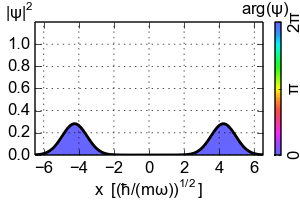 | ||
In quantum computing, the cat state, named after Schrödinger's cat, is the special pure quantum state where the qubits are in an equal superposition of all being |0> and all being |1>, i.e. (in bra–ket notation): |00⋯0> + |11⋯1>.
Contents
In other quantum mechanics contexts, according to The New York Times for example, physicists view the cat state as composed of two diametrically opposed conditions at the same time, such as the possibilities that a cat be alive and dead at the same time. This is sometimes connected to the many worlds hypothesis by proponents of the many worlds interpretation of quantum mechanics. More prosaically, a cat state might be the possibilities that six atoms be spin up and spin down, as published by a team led by David Wineland at NIST, December 1, 2005. Large cat states have also been experimentally created using photons by a team led by Jian-Wei Pan at University of Science and Technology of China, for instance, four-photon entanglement, five-photon entanglement, six-photon entanglement, eight-photon entanglement, and five-photon ten-qubit cat state. This spin up/down formulation was proposed by David Bohm, who conceived of spin as an observable in a version of thought experiments formulated in the 1935 EPR paradox.
In quantum optics
In quantum optics, a cat state is defined as the coherent superposition of two coherent states with opposite phase:
where
and
are coherent states defined in the number (Fock) basis. Notice that if we add the two states together, the resulting cat state only contains even Fock state terms
As a result of this property, the above cat state is often referred to as an even cat state. Alternatively, we can define an odd cat state as
which only contains odd Fock states
Even and odd coherent states were first introduced by Dodonov, Malkin, and Man'ko in 1974.
Linear superposition of coherent states
A simple example of a cat state is a linear superposition of coherent states with opposite phases, when each state has the same weight:
